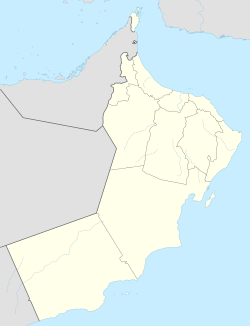A' Sunaynah (Arabic: ٱلسُّنَيْنَة, romanized: As-Sunaynah) is a Wilayah (Province) in Al Buraimi Governorate, northeastern Oman. The village contains a substantial area of greenery and is described "remote, even by Omani standards".[2] A' Sunaynah is known for its traditional camel races as well as textile and weaving industries.[3] The wilaya is reportedly occupied by the Al Nuaimi tribe; in the 1960s the tamimah of the Al Nuaim was reported to be 'Ali ibn Hamuda of the Al Bu Khuraiban division, who lived at Sunainah.[4]
As-Sunaynah
| |
|---|---|
Village / Wilayah | |
| Coordinates: 23°36′N 55°58′E / 23.600°N 55.967°E | |
| Country | |
| Region | Al Buraimi Governorate |
| Population (2020)[1] | |
| • Total | 1,474 |
| Time zone | UTC+4 (Oman Standard Time) |
Some of its important villages include Ain Al Hulwah (Al Malhah), Al Silahiyah, Al Qabil, and Hafit. Notable natural landmarks in A' Sunaynah include Jebel Hafit and the diverse natural sand dunes with shades ranging from light red to dark yellow.The wilaya also features many pastoral plains, which provide fertile grazing land for camels, especially after the rainy season. The wilaya is crossed by several valleys descending from the Hajar Mountains towards the Empty Quarter, such as Wadi Al Fath.[5]
Location edit
The Wilayat of A' Sunaynah is located on the northwestern border of the Sultanate of Oman with the United Arab Emirates. To the south, it is bordered by the valleys of the Al Aziz tribe, also known as the Al Azizi tribe, situated on a semi-desert plain that descends from the western slopes of the Hajar Mountains towards the Rub' al Khali desert. The wilaya is predominantly characterized by a desert landscape, with extensive sand dunes extending from the Rub' al Khali to the west and southwest of the wilaya. A' Sunaynah is considered one of the main strongholds of the Al Bu Shamis tribe.
Government Services edit
The wilaya has been provided with various government services offered by the Omani government to its citizens, including schools, roads, healthcare centers, and government buildings that provide various services to the residents.
Economy edit
Oil is found nearby in the Sala field and began mass commercial production in February 1984,[6] although mention of oil drilling in the area was discussed back in the 1970s.[7] the Sunaynah concession is operated 65 per cent by Occidental Petroleum Oman and 35 per cent by Gulf Oil Oman as of 1985.[8] Chevron was said to have "offered its 18.2 per cent holding in Sunainah acreage".[9] In the mid 1980s, test drilling by Occidental Oman, a subsidiary of the US' Occidental Petroleum Corporation, identified a potential output of 15000-20000 barrels a day from its Sunainah concession.[10]
In March 2004, a 72-F fibre optic cable was laid from Sunaynah to the district capital of Ibri by the Oman Telecommunications Company.[11]
Aflaj edit
The A' Sunaynah Wilaya in Al Buraimi Governorate has been renowned for its numerous aflaj (irrigation channels) since ancient times. Some of the most important ones include Al Rayhani, Falaj A' Sunaynah, Al Harmouzi, Al Mashrouh, Khayla, Al Ghubay, Al Barim, and Al Raki.
The aflaj in A' Sunaynah Wilaya, such as Al Raki and A' Sunaynah (from which the wilaya gets its name), are part of the Dawoodi irrigation system. These aflaj continue to flow in the region to this day, assisted by pumps, and they are regularly maintained.[12]
Jebel Hafeet edit
Jebel Hafeet is the largest peak of a range of triple-crested mountains located on the western side of the Hajar Mountains chain. This massive mountain cuts across several wadis that flow on its eastern and western sides, with the most significant being Wadi Hafeet. The United Arab Emirates built dams in the course of this wadi, blocking its flow to Hafeet and Qadadah, primarily due to side effects on the groundwater reservoir. Despite residents' demands to restore the wadi to its natural course to rejuvenate the region's greenery and beauty (as over 85% of orchards and farms have suffered), these efforts have been in vain.
Jebel Hafeet rises 1,300 meters above sea level and serves as the boundary marker between the United Arab Emirates and the Sultanate of Oman in the Hafeet region of the Al Buraimi Governorate. The mountain is characterized by numerous fissures that come in various forms, such as extended, twisted, or reverse fractures. The northern and western third of the mountain belongs to the United Arab Emirates, while the remaining two-thirds are part of the Sultanate of Oman.
See also edit
References edit
- ^ "Population - DATA PORTAL". National Centre for Statistics & Information. Retrieved 2021-10-15.
- ^ Ashmole, Alan (28 October 2010). Sand, Oil & Dollars: The Adventures of an Expatriate British Bank Manager in the Middle East in the 1950s, 1960s and 1970s. AuthorHouse. p. 133. ISBN 978-1-4490-6448-8. Retrieved 11 May 2011.
- ^ "الحرف التقليدية في ولاية السنينة". Oman Info. 20 October 2023. Retrieved 20 October 2023.
- ^ Kelly, John Barrett (1968). Britain and the Persian Gulf. 1795-1880. Clarendon P. ISBN 978-0-19-821360-4. Retrieved 11 May 2011.
- ^ "ولاية السنينة". Oman Info. 20 October 2023. Retrieved 20 October 2023.
- ^ The Petroleum economist. Petroleum Press Bureau. March 1985. Retrieved 11 May 2011.
- ^ Standard Chartered Bank (1978). Standard chartered review. Standard Chartered Bank. Retrieved 11 May 2011.
- ^ ṿe-Afriḳah, Mekhon Shiloaḥ le-ḥeḳer ha-Mizraḥ ha-tikhon (1985). Mideast file. Learned Information. Retrieved 11 May 2011.
- ^ Country profile: Oman, the Yemens. The Unit. 1991. Retrieved 11 May 2011.
- ^ Collard, Elizabeth (1986). Middle East economic digest. Middle East Economic Digest, Ltd. Retrieved 11 May 2011.
- ^ MEED. Economic East Economic Digest, ltd. 2004. Retrieved 11 May 2011.
- ^ العريمي, محمد (2021-03-16). "تعرّف على أهم أفلاج ولاية السنينة". صحيفة أثير الإلكترونية (in Arabic). Retrieved 2023-10-20.


